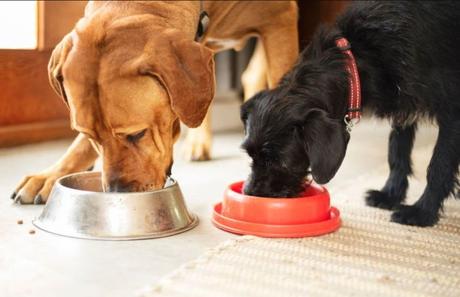You may think that to switch to raw food, your dog has to look like a wolf, but this isn't the case. Even the smallest pup's body will function like a wolf's to some degree; it's a part of their natural makeup! Raw dog food mimics the natural ancestral diet of wild wolves and what they evolved to eat, providing raw nutrients for your pup.
Some canine experts believe it is a healthy diet for dogs, but as with most things, there are many disapprovers too. If you're unsure about anything, it's always best to do your research and consult your local veterinarian to help you decide what's best for your dog.
This article will explore some of the pros and cons of a raw dog food diet.

Raw food diets for dogs are not new, but they've certainly skyrocketed in popularity over the last few years.
Veterinarian Dr. Ian Billinghurst revolutionized the movement by creating the first biologically approved raw food diet for dogs made of fresh ingredients. It included ingredients such as:
It is worth mentioning that it is not recommended that you throw out all kinds of store-bought dog food you've been feeding your four-legged friend. While your dog's ancestors may have thrived on a raw diet doesn't mean to say that your dog's modern diet is all that bad.
Though a raw-food option may offer your dog a less-processed diet, that isn't to say that all dog food is bad for your dog. Hypoallergenic options can also be lifesavers for dogs with intolerances, and you will need to learn how to prepare or source raw dog food before making the switch.
That being said, the downside to commercially bought products is that alongside containing all the right vitamins and minerals that your dog needs, they may also contain a range of unhealthy ingredients, including fillers, animal by-products and artificial colors, and flavors and preservatives. So if you're looking to cancel out some of these harmful ingredients, raw dog food is well worth considering.

Why Switch To Raw Dog Food?
Some of the benefits of switching to raw dog food dieting include:
- Healthier coat condition
- Improved skin health
- Increased energy levels
- Better dental care
- Stronger immune system
- Lower risk for disease and allergies
Sometimes it can be difficult to visualize how a raw diet could be better for your dog than food engineered to be 'healthy', but avoiding preservatives and additives in processed foods can work wonders for your dog's health.
A dog is a natural creature. In the wild, it wouldn't have access to processed kibbles and would have to survive on a natural diet. It can benefit your dog's health to revert to this new diet.
Issues With Raw Dog Food
There are many practical factors to consider with raw food diets too. You're paying for sourcing and balancing the ingredients, packaging, and delivery when purchasing raw food.
You may lose the convenience of being able to go and pick up a bag of food from a local store. As well as that, you will most likely need to freeze or refrigerate raw food, so you better account for space too.
With raw dog food comes the risk of foodborne illnesses and bacteria from germs such as Salmonella and E. coli. By law, all raw dog food products must be subjected to a process to eliminate all pathogens due to the risk of them causing dog illness.
Whilst most products should be safe; you should always clean and disinfect all surfaces and objects that come in combat with raw pet food. These could be microwaves, work surfaces, storage cabinets and utensils.
You should freeze raw foods until you are ready to use them, as this is the best way to keep them fresh for longer. If possible, isolate the raw pet food away from other forms of food in the fridge/freezer.
Frozen Raw Food vs Freeze-Dried Dog Food
If at this point, you are considering raw dog food as an option for your dog, then you will need to decide between frozen or freeze-dried.
Like most food, freezing is the best and easiest way to prevent food from spoiling. The downside, of course, is that you'll need to have that space in the freezer and then have the time to thaw it before feeding, which may not suit a busy lifestyle.
On the other hand, freeze-dried food is a faster and more convenient option for many consumers. There is no time spent thawing, and the product can easily be stacked on a shelf at room temperature, freeing up a lot of space in your freezer!
Raw dog food has many pros and cons, all of which should be considered before making the switch.
If it tickles your fancy, consult with your local vet to ensure that it is the best decision for your dog. All dogs are different, so it is always worth checking with a professional before moving forward, especially if your dog has any intolerances or allergies.
Good luck with the transition, and remember to integrate it into the diet slowly and carefully, so your furry friend has time to adapt!
RELATED POST